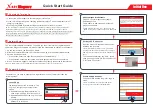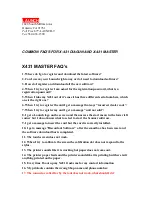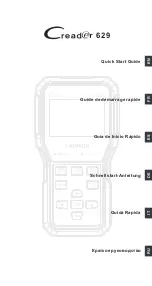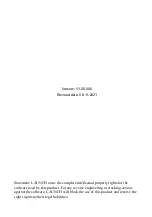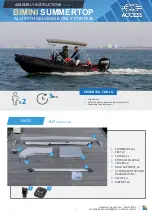
5
Side Rails / Patient Restraints
- Whether and how to use side rails or restraints is
a decision that should be based on each patient’s needs and should be made by the
patient and the patient’s family, physician and caregivers, with facility protocols in
mind. Caregivers should assess risks and benefits of side rail / restraint use (including
entrapment and patient falls from bed) in conjunction with individual patient needs, and
should discuss use or non-use with patient and / or family. Consider not only the clinical
and other needs of the patient but also the risks of fatal or serious injury from falling out of
bed and from patient entrapment in or around the side rails, restraints or other accessories.
In the US, for a description of entrapment hazards, vulnerable patient profile and guidance
to further reduce entrapment risks, refer to FDA’s Hospital Bed System Dimensional
and Assessment Guidance To Reduce Entrapment. Outside the US, consult the local
Competent Authority or Government Agency for Medical Device Safety for specific local
guidance. Consult a caregiver and carefully consider the use of bolsters, positioning aids
or floor pads, especially with confused, restless or agitated patients. It is recommended
that side rails (if used) be locked in the full upright position when the patient is unattended.
Make sure a capable patient knows how to get out of bed safely (and, if necessary, how
to release the side rails) in case of fire or other emergency. Monitor patients frequently to
guard against patient entrapment.
CAUTION: When selecting a standard mattress, ensure the distance
between top of side rails (if used) and top of mattress (without
compression) is at least 8.66 in (220 mm) to help prevent inadvertent
bed exit or falls. Consider individual patient size, position (relative to
the top of the side rail) and patient condition in assessing fall risk.
I.V. and Drainage Tubes –
I.V. and drainage tubes should always have slack for
alternating pressure or rotation and other patient movements.
Skin Care –
Monitor skin conditions regularly and consider adjunct or alternative therapies
for high acuity patients. Give extra attention to any possible pressure points and locations
where moisture or incontinence may occur or collect. Early intervention may be essential
to preventing skin breakdown.
Fluids –
Avoid spilling fluids on pump controls. If spills do occur, clean fluid from pump
wearing rubber gloves or while unit is unplugged to avoid any possibility of shock. Once
fluid is removed, check operation of components in area of spill.
Fluids remaining on controls can cause corrosion, which may cause
components to fail or operate erratically, possibly producing potential
hazards for patient and staff.
Avoid Fire Hazards –
To minimize risk of fire, connect the bed’s power cord directly into a
wall-mounted outlet. Do not use extension cords or multiple outlet strips. In the US, review
and follow FDA’s Safety Tips for Preventing Hospital Bed Fires.
No Smoking in Bed –
Smoking in bed can be dangerous. To avoid the risk of fire,
smoking in bed should never be allowed.
Power Cord –
Position power cord to avoid a tripping hazard and / or damage to the cord.
Ensure power cord is kept free from all pinch points and moving parts and is not trapped
under casters. Improper handling of the power cord can cause damage to the cord, which
may possibly produce risk of fire or electric shock.
General Protocols –
Follow all applicable safety rules and institution protocols concerning
patient and caregiver safety.
Содержание AtmosAir SAT 4000 Series
Страница 4: ...iv Intentionally left blank...
Страница 6: ...2 Intentionally left blank...
Страница 37: ...33 Intentionally left blank...
Страница 38: ...34 Intentionally left blank...


































